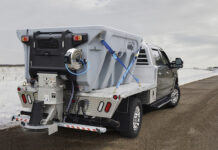If you’ve thought about repurposing one of your fertilizer sprayers for anti-icing and deicing applications, you’re not alone. In recent years, many snow and ice management contractors have tried rigging up their own brine sprayers as a way to combat salt supply challenges. However, many of these systems have failed in the field.
It’s hard to blame someone for being inventive and trying to maximize equipment utilization, but these malfunctions can often be avoided by using sprayers that are purpose-built for anti-icing and deicing. So, before attempting to use one of your existing sprayers for ice management, consider these six reasons why you shouldn’t.
1. Material compatibility
Ice management materials are different than most other types of materials, and this doesn’t just apply to liquids. For instance, bagged salt is much larger and heavier than granular fertilizer, so if a contractor tries to spread salt through a push spreader designed for fertilizer, it won’t work well. Push spreaders made specifically for ice management have larger openings and higher capacities to handle salt better.
Likewise, the liquids used in snow and ice management are different than many other types of liquids, such as pesticides, herbicides, insecticides or fertilizers. Therefore, they require different kinds of pumps and filtration systems to handle the material. They also feature specialized components to help resist corrosion. If you use a standard fertilizer sprayer to apply brine, the sprayer’s filters could result in poor performance and premature pump failure. Also, corrosion could cut the sprayer’s service life extra short.
Booms and nozzles make a big difference in performance. Many fertilizer sprayers don’t have booms designed for use on the backs of trucks, requiring the contractor to make his own out of a pipe or inferior materials. The ones that do come with booms generally have fan-style nozzles that produce fine droplets, which don’t work well for winter maintenance work. Anti-icing and deicing applications require much greater volumes of liquid, which are applied with higher output jet nozzles or triple-stream nozzles, rather than the fan style.
Some of the anti-icing and deicing sprayers on the market come with rotating nozzle assemblies. This allows you to quickly change nozzles for higher or lower output, depending on how fast he plans to drive on the job. This ability boosts efficiency by letting you work at your chosen pace, rather than requiring you to drive according to a set nozzle output.

2. Application efficiency
Not all sprayers work the same. A standard fertilizer sprayer will have a simple on/off switch for the pump, whereas some of the more sophisticated anti-icing and deicing sprayers offer advanced controls for higher efficiency and improved results.
For example, some manufacturers offer units that can be equipped with GPS speed sensors, which detect the vehicle’s speed and transmit the data to the sprayer’s controller. The system then automatically adjusts the liquid flow to achieve the specified application rate. A feature like this is a big help to inexperienced operators as it takes much of the guesswork out of liquid applications. A GPS speed sensor maximizes efficiency to help keep material costs to a minimum.
3. Weather worries
Nothing seems to function the same in the bitter cold. Vehicles turn over harder; batteries discharge faster, the list goes on. Sprayers can have trouble, too, if they aren’t intended for use in winter weather.
Manufacturers build sprayers for snow and ice management with cold-weather performance top-of-mind. They select all components, from the fittings to the pumps, based on their ability to handle the harsh conditions. As a result, the equipment is less likely to fail when temperatures fall.
4. Clean-out considerations
If one sprayer is used for both fertilizer and brine, then you must flush it thoroughly when switching between applications. Otherwise, any liquid fertilizer left in the system may freeze and damage the equipment when used for winter maintenance. On the other hand, it can be difficult to rid the system entirely of brine when preparing the sprayer for fertilizer applications. Any leftover brine in the booms could cause severe damage to the turf, which, in turn, could cause serious problems for you.

5. Safety hazards
Keep in mind that many fertilizer sprayers have white tanks with basic pipes, hoses and reels. During a winter storm, these products tend to blend in visually, which could pose a safety threat to pedestrians and vehicle traffic in the area of application.
On the other hand, the anti-icing and deicing sprayers offered by manufacturers often have brightly colored tanks and components. This isn’t done just for looks; the more vivid colors help increase visibility.
6. Sales success
When approaching existing and potential clients, you should always display a high level of professionalism, both in demeanor and with equipment. Having a professional looking fleet will gain you a greater standard of respect and trust.
Remember, it can be hard enough for a contractor to convince a client to anti-ice in the first place. It will be even more difficult if your equipment looks shoddy. Think of your equipment as a sales tool, not just an application tool.
For these reasons, use your fertilizer sprayers for their intended purposes and go with something engineered specifically to handle brine. Snow and ice management is demanding and warrants its own purpose-built equipment. Don’t sacrifice performance or efficiency with inadequate equipment. Don’t risk being stuck in the cold with a product that isn’t designed for use in winter.











![[VIDEO] Dickies®: Discover Workwear That’s Anything But Uniform](https://turfmagazine.com/wp-content/uploads/2023/06/1647663814-4b1a2a7742790a9b1e97a3b963477850192e1d6a9dfba9b07214a77bae25d6e3-d-218x150.jpg)































![[VIDEO] Dickies®: Discover Workwear That’s Anything But Uniform](https://turfmagazine.com/wp-content/uploads/2023/06/1647663814-4b1a2a7742790a9b1e97a3b963477850192e1d6a9dfba9b07214a77bae25d6e3-d-324x160.jpg)